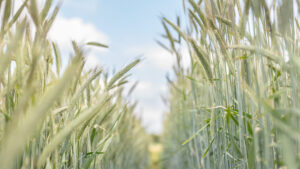
Plant Breeders’ Perspectives
From the global acceptance of biotech crops to if — and how — private and public plant breeders can work together, plant breeders and biotech innovators from Alberta and Manitoba weigh in on the future of plant breeding.
Pat Juskiw, PhD, M.Sc, B.Sc. Agric., P.Ag.
Surya Acharya, PhD
Jamie Larsen, PhD
Kevin McCallum
Germination: Do you think acceptance of biotechnology is limiting variety and market development?
PJ: Acceptance of biotechnology isn’t limiting the development of new varieties overall, however it does limit the market development of new varieties. The problem with biotechnology is that everyone thinks that biotech equals GMO — and it’s just not true. The public’s linkage of the two is harmful. It’s a matter of educating people about the differences. Australia does a great job and has overcome pushbacks from Asia with regard to cereal crops developed using marker-assisted selection (biotech crops).
SA: Overall, it has definitely had an impact, but not so much on forages as other crops. For example, in forages there is only one, and that is a Roundup Ready alfalfa. What has had an impact is that everybody is waiting for a biotech crop because they think that will be substantially better than traditional cultivars. Only a few people are willing to buy the new non-GMO cultivars that are ready now, and consequently there is less money available for research. This is especially important for perennial forage crops as everyone is waiting for that big breakthrough.
KM: No, not in the canola industry. The major markets for Canadian canola have accepted biotechnology.
JL: No, not from a North American perspective at least.
Germination: What do you think will be the next genetic or trait development breakthrough we will see commercialized?
PJ: The whole idea of genomics and marker-assisted selection is amazing. It’s now more affordable, easier and faster — we can run hundreds of screenings. We will not be cutting and slicing genes to make GMOs, but the new technology will help us find gene combinations that naturally occur. Using genomics as a tool will allow us to screen vastly increased numbers of plants that may allow us to identify naturally occurring changes in gene combinations that are beneficial.
SA: In forages, the next breakthrough will be the commercial availability of low lignin alfalfa. This GMO alfalfa will make it easier for producers to harvest the crop at a later stage — at up to 50 to 60 per cent flowering — without losing quality or biomass. This could have a positive impact on some producers who have difficulty harvesting alfalfa at prime stage (five per cent bloom) and may save a little bit of money, as only two cuts would be needed, instead of three in good growing conditions.
KM: In canola, the next impact trait will be the second generation of glyphosate-tolerant varieties.
JL: This is quite difficult to predict and is a matter of perspective and timeframe. I think the general trend will be that private industry continues to stack new herbicide and pest resistance traits. This may be important as models generally predict an expanded range for a number of important crop pests. Also, some of these traits could be extremely important to maintain operational efficiency. For me, a major breakthrough would be the development of perennial wheat and perennial cereal rye, which will have a profound impact on farming operations including a significant reduction in production costs, the opportunity to conserve and improve soil quality and make better use of available water and nutrients. Perennial cereals also present an opportunity for mixed farming operations to graze top growth in the spring and fall — extending field grazing periods. A close second and more likely to be reached in the mid-term is the unlocking of further cold tolerance in winter cereals and winter canola, facilitating a paradigm shift in Western Canada agriculture. Fall-sown winter crops provide multiple production and logistical advantages over spring cereals and would provide a significant boost in yield to meet global demand.
Germination: What crops do you think will benefit the most from advances in plant breeding and genome research in the next five to 10 years?
PJ: Remember when barley used to be weedy and full of off-types? Now it’s an elite crop for malting because of regular plant breeding, but we can take it to new yield and disease resistance plateaus using biotechnology. Using genomics, cereals like hard red spring wheat and malting barley will benefit with improvements in disease resistance and increased yields. Five years from now we might see new linkages in malting barley and they will all be non-GMO. There is also potential for triticale to improve quality traits for bread production.
KM: Tough question to answer because DL Seeds focus on canola, but in the next five to 10 years, wheat could benefit the most if the industry can successfully develop hybrid technology in that crop. In canola, there is already quite a bit of investment and advancements ongoing already.
JL: This timeframe is too short for a number of major crops to take advantage of the massive genomics and biotechnology efforts currently underway. In this timeframe, probably canola and other brassicas will benefit tremendously from previous genomics efforts in related species (Brassica rapa and model plant, Arabidopsis). Genomic sequencing cereals for western Canadian producers has currently been completed, or is getting close to completion. The timeframe to make use of this research is more likely 10 years and beyond, especially if we are talking about direct applications resulting in variety improvement.
Germination: Are the roles of public plant breeders different than private breeders? How will private and public plant breeders work together in the future?
PJ: A plant breeder working for a private company may not have the same goal as a public plant breeder. Private plant breeders are primarily focused on breeding for yield. A public plant breeder is very concerned about reducing risk to the public and disease resistance is part of that. Public breeders work extensively with pathologists and we work to maintain quality standards. In Canada, we have a very good cooperative model where public and private plant breeders share germplasm, disease assessment and yield information. This should and will continue.
SA: In forages, there are no private plant breeders at this time. The role of public forage breeders is different in the sense that they do not have to worry about profitability from their cultivars. Perennial crops are seeded less frequently than annual crops and so the profit margin from them would be less than perennial crops. That may be the reason why private companies are not too involved in perennial crops in Canada. As a public forage breeder, I do not hesitate to develop crops for niche markets (saline and acid soils) and that have a six- or seven-year stand life even though the cultivar will have a smaller market and will be sold less frequently. This will not be of interest to private breeders. But, public and private breeders can work together to take care of all producer needs and [work] towards sustainability of the entire industry.
KM: At the fundamental plant breeder level, the roles are the same — to create superior varieties, no matter if you are a public or private breeder. Public and private breeders will continue to work together, as in the past, creating even more substantial agreements going forward. DL Seeds, as a small breeding company, relies on its partnership with many public breeding programs today and will into the future.
JL: In my opinion, public and private plant breeders strive towards the same goal, which is to release improved varieties for farmers. Where they differ is the latitude of exploration into new areas or to incorporate new traits from exotic, less-adapted germplasm. Private plant breeders work for companies that only function if they turn a profit, therefore the approach to breeding must be direct, with a clear marketable product as an end result. Public plant breeders function, generally, through base funding from their organization, but derive significant levels of funding for their programs from funding bodies that are interested in research that is targeted to address a specific threat or long-term public good research. In public breeding, there is more opportunity to examine the underlying mechanism of a specific observed trait and provide an explanation which will lead to an understanding [of], and perhaps more effective, deployment of the trait. It is important that private and public plant breeders work together in the future. Private-public partnerships are becoming more commonplace as there are opportunities for each group to make use of complementing strengths. For perennial cereals, I believe the development of this crop will follow the more traditional method where public researchers develop varieties and the production system, followed by industry, recognizing the merit in perennial cereals which leads to further development of perennial cereals into a mature production system. Jennifer Pinarski
Germination: Using certified seed helps fund innovation in the seed industry. What are the Top 3 reasons why farmers should use certified seed?
PJ: 1) You know what you’re growing and you can be confident that it has all the strengths of that variety.
2) You reduce pests and other diseases. Certified seed is meticulously cared for and when planted in clean and properly cared-for soil, off-types are prevented.
3) It funds innovation. When you buy certified seed, royalties from the seed go back to the breeders. That shows the value of the seed.
SA: 1) Royalties from certified forage seed sale are reinvested into innovation work, which is extremely important for crops that are used in-house, as their value is difficult to estimate otherwise.
2) Producers can expect known performance, and this is important for producers who are interested in growing high-quality hay.
3) Less weeds and problems with disease and insects. Common seeds are a little bit cheaper, but the buyer has no idea what they are buying in terms of number of weed seeds, other foreign material in the lot and the cultivar adaptation to the area etc. Certified seed is clean and the cultivar should have a proven track record.
KM: 1) For guaranteed performance.
2) To help obtain full yield potential of management practices.
3) Investment back into development of new higher-yielding varieties. At DL Seeds we spend large amounts of resources making sure that the seed we produce meets or exceeds certified standards.
JL: 1) Maintaining a competitive advantage. The new varieties purchased through certified seed contribute to improved production efficiency of farming operations through improved yield or improved pest resistance, which reduces costs associated with chemical applications.
2) Innovation is not cheap. Estimated costs to produce a new variety can easily be in the millions of dollars. Buying certified seed ensures that innovation will continue through payment of royalties to breeding programs.
3) Risk reduction and marketing advantages. Certified seed is guaranteed to be clean seed, derived from inspected fields of a specific variety with a known quality profile. Quality assurance [has] a major advantage for grain farmers in Canada and a reputation that must be upheld to maintain or expand marketing opportunities.
Germination: What breeding accomplishment are you most proud of?
PJ: While I could name varieties I’ve worked on that I’m proud of, it’s working with other people I am most proud of — agronomists and a huge contingent of pathologists, genomic experts … It’s not just me — we are all working together to look at new ways to grow things and make agriculture in Canada profitable and sustainable.
SA: I am proud of all of my accomplishments, but the highlight of my work is the development of a sainfoin cultivar with ability to grow with alfalfa to prevent pasture bloat. When I started working here as a forage breeder, there were 100 varieties of alfalfa on our recommended list and breeding alfalfa was to be my focus. I deviated from that a bit and started looking at alternative crops for producers who can’t easily grow alfalfa because of pocket gophers or bloat problems associated with pasture bloat. Cicer milkvetch and sainfoin are high-quality forage legumes, they do not cause bloat and you can graze them easily. Sainfoin quality and biomass productivity is close to alfalfa and it has the added benefit of bypass protein. In 2015, the new cultivar AAC Mountainview will be available, and the indications are that producers are all waiting anxiously to begin seeding it with alfalfa.
KM: For a breeder, that is an easy question: variety market share. It means that all the hard work that went into developing a new variety is valued by farmers, with them growing it on their land.
JL: I lead the perennial cereals (wheat and rye) and fall rye breeding program which was started from scratch two years ago. Due to this limited timeframe, the release of new varieties from my program will be a ways down the road. Perennial cereals are currently not available to producers, but would represent a more sustainable and efficient cropping system, reducing inputs and improving water and nutrient capture. Targeted lifespan of a perennial cereal is three years. I am proud of our accomplishments thus far with regards to the development of perennial cereals, especially several proof-of-concept experiments demonstrating our ability to produce and evaluate new germplasm developed from difficult crosses between distantly-related species. This has led to the expansion of the program with more a targeted approach, making use of local breeding germplasm, as well as germplasm from collaborators in the United States and gene banks worldwide. We are also beginning exploratory genomics work to determine molecular basis of the perennial habit in the closest-related perennial ancestor to wheat. This research has the potential to accelerate the development of perennial wheat and cereal rye tremendously through marker-assisted selection and advanced molecular breeding. I am also quite proud of progress we have made in fall rye. We have acquired germplasm with specific traits like improved falling number, alternative types of dwarfing genes and improved biomass quality. These traits have been incorporated into Canadian adapted germplasm, which puts most of the footings in place to develop exceptional open-pollinated fall rye varieties for Western Canada.












